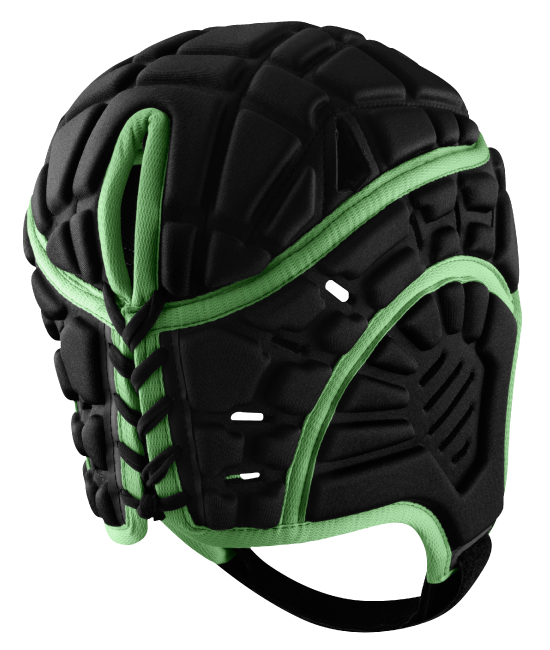If a concussion or brain injury is suspected, you should seek immediate medical attention.
While N-Pro can achieve impressive results, no product can claim to be 100% effective all the time in relation to head trauma prevention. N-Pro is designed, and extensively tested, to protect the head from non-penetrating direct impacts; one of the major contributory risk factors in sports-induced head trauma. N-Pro is not guaranteed to work in every individual instance and no implied or expressed guarantee or warranty are made or given that it will always prevent injury in sporting activities. Except where expressly set out in these terms, all warranties, conditions or other terms implied by statute or common law are excluded to the fullest extent permitted by law.
Concussion is a subset of Traumatic Brain Injury (TBI), below is an excerpt from the “Consensus statement on concussion in sport: the 4th International Conference on Concussion in Sport held in Zurich, November 2012” detailing its definition and some of its symptoms.
Concussion is a brain injury and is defined as a complex pathophysiological process affecting the brain, induced by biomechanical forces. Several common features that incorporate clinical, pathologic and biomechanical injury constructs that may be utilised in defining the nature of a concussive head injury include:
- Concussion may be caused either by a direct blow to the head, face, neck or elsewhere on the body with an ‘‘impulsive’ force transmitted to the head.
- Concussion typically results in the rapid onset of short-lived impairment of neurological function that resolves spontaneously. However, in some cases, symptoms and signs may evolve over a number of minutes to hours.
- Concussion may result in neuropathological changes, but the acute clinical symptoms largely reflect a functional disturbance rather than a structural injury and, as such, no abnormality is seen on standard structural neuroimaging studies.
- Concussion results in a graded set of clinical symptoms that may or may not involve loss of consciousness. Resolution of the clinical and cognitive symptoms typically follows a sequential course. However, it is important to note that in some cases symptoms may be prolonged.
The majority (80–90%) of concussions resolve in a short (7–10 day) period, although the recovery time frame may be longer in children and adolescents.
The diagnosis of acute concussion usually involves the assessment of a range of domains including clinical symptoms, physical signs, cognitive impairment, neurobehavioural features and sleep disturbance. Furthermore, a detailed concussion history is an important part of the evaluation both in the injured athlete and when conducting a preparticipation examination. The detailed clinical assessment of concussion is outlined in the SCAT3 and Child SCAT3 forms.
The suspected diagnosis of concussion can include one or more of the following clinical domains:
- Symptoms—somatic (eg, headache), cognitive (eg, feeling like in a fog) and/or emotional symptoms (eg, lability);
- Physical signs (eg, loss of consciousness (LOC), amnesia);
- Behavioural changes (eg, irritability);
- Cognitive impairment (eg, slowed reaction times);
- Sleep disturbance (eg, insomnia).
If any one or more of these components are present, a concussion should be suspected and the appropriate management strategy instituted.
When a player shows ANY features of a concussion:
- The player should be evaluated by a physician or other licensed healthcare provider onsite using standard emergency management principles and particular attention should be given to excluding a cervical spine injury.
- The appropriate disposition of the player must be determined by the treating healthcare provider in a timely manner. If no healthcare provider is available, the player should be safely removed from practice or play and urgent referral to a physician arranged.
- Once the first aid issues are addressed, an assessment of the concussive injury should be made using the SCAT3 or other sideline assessment tools.
- The player should not be left alone following the injury and serial monitoring for deterioration is essential over the initial few hours following injury.
- A player with diagnosed concussion should not be allowed to RTP on the day of injury.
Sufficient time for assessment and adequate facilities should be provided for the appropriate medical assessment both on and off the field for all injured athletes. In some sports, this may require rule change to allow an appropriate off-field medical assessment to occur without affecting the flow of the game or unduly penalising the injured player's team. The final determination regarding concussion diagnosis and/or fitness to play is a medical decision based on clinical judgement.
Sideline evaluation of cognitive function is an essential component in the assessment of this injury. Brief neuropsychological test batteries that assess attention and memory function have been shown to be practical and effective. Such tests include the SCAT3, which incorporates the Maddocks’ questions4 ,5 and the Standardized Assessment of Concussion (SAC).6–8 It is worth noting that standard orientation questions (eg, time, place and person) have been shown to be unreliable in the sporting situation when compared with memory assessment.5 ,9 It is recognised, however, that abbreviated testing paradigms are designed for rapid concussion screening on the sidelines and are not meant to replace comprehensive neuropsychological testing which should ideally be performed by trained neuropsychologists who are sensitive to subtle deficits that may exist beyond the acute episode; nor should they be used as a stand-alone tool for the ongoing management of sports concussions.
"It should also be recognised that the appearance of symptoms or cognitive deficit might be delayed several hours following a concussive episode and that concussion should be seen as an evolving injury in the acute stage."
from McCrory et. al, Consensus Statement on Concussion in Sport. Br J Sports Med 47 (5), 2013








